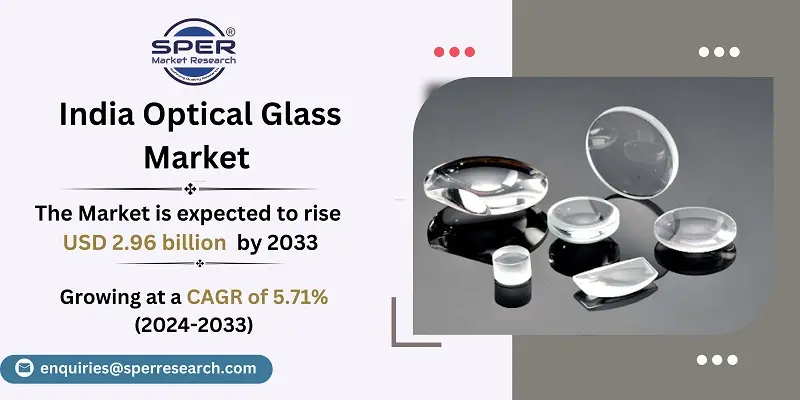
India Optical Glass Market Growth, Size, Trends, Demand, Share, Revenue and Future Outlook
India Optical Glass Market Size- By Product, By End User Industry- Regional Outlook, Competitive Strategies and Segment Forecast to 2033
| Published: May-2024 | Report ID: CHEM2454 | Pages: 1 - 106 | Formats*: |
| Category : Chemical & Materials | |||
- July 2020; With the introduction of Gorilla Glass Victus, Corning Incorporated made a revolutionary breakthrough in robust optical glass. With its much better scratch resistance and drop performance, this new glass is perfect for consumer electronics like laptops, tablets, and smartphones. Gorilla Glass Victus addressed the growing need for more robust screen protection in portable devices by setting a new benchmark for toughness and durability.
- February 2021; A high-performance aluminosilicate glass called Xensation® Up. was introduced by Schott AG specifically for use in mobile device displays. This new product met the growing demand for sturdy and dependable screen materials in the consumer electronics market by offering improved drop resistance and durability. A notable development in the optical glass industry, Xensation® Up. highlighted Schott's dedication to excellence and innovation.


| Report Metric | Details |
| Market size available for years | 2020-2033 |
| Base year considered | 2023 |
| Forecast period | 2024-2033 |
| Segments covered | By Product, By End-User Industry |
| Regions covered | Maharashtra, Karnataka, Tamil Nadu, Delhi, Gujrat, Telangana, Uttar Pradesh, West Bengal, Rest of India. |
| Companies Covered | AGC Inc., Corning Incorporated, Edmund Optics, Hoya Corporation, Nikon Corporation, Ohara Corporation, Schott AG, Thorlabs Inc., Tokyo Glass Co., Ltd. |
- Manufacturers and Suppliers
- Investors and analysts
- Research and development companies
- Government and Regulatory Bodies
- Academic and education universities
- consulting firms
- Marketing and Sales Teams
| By Product: |
|
| By End-Users Industry: |
|
| By Region: |
|
- India Optical Glass Market Size (FY’2024-FY’2033)
- Overview of India Optical Glass Market
- Segmentation of India Optical Glass Market By Product (Annealed glass, Coater Glass, Reflective Glass, Processed Glass, Mirrors)
- Segmentation of India Optical Glass Market By End-Users Industry (Building and Construction, Automotive, Solar Glass)
- Statistical Snap of India Optical Glass Market
- Expansion Analysis of India Optical Glass Market
- Problems and Obstacles in India Optical Glass Market
- Competitive Landscape in the India Optical Glass Market
- Impact of COVID-19 and Demonetization on India Optical Glass Market
- Details on Current Investment in India Optical Glass Market
- Competitive Analysis of India Optical Glass Market
- Prominent Players in the India Optical Glass Market
- SWOT Analysis of India Optical Glass Market
- India Optical Glass Market Future Outlook and Projections (FY’2024-FY’2033)
- Recommendations from Analyst
1.1. Scope of the report1.2. Market segment analysis
2.1. Research data source2.1.1. Secondary Data2.1.2. Primary Data2.1.3. SPER’s internal database2.1.4. Premium insight from KOL’s2.2. Market size estimation2.2.1. Top-down and Bottom-up approach2.3. Data triangulation
4.1. Driver, Restraint, Opportunity and Challenges analysis4.1.1. Drivers4.1.2. Restraints4.1.3. Opportunities4.1.4. Challenges4.2. COVID-19 Impacts of the India Optical Glass Market.
5.1. SWOT Analysis5.1.1. Strengths5.1.2. Weaknesses5.1.3. Opportunities5.1.4. Threats5.2. PESTEL Analysis5.2.1. Political Landscape5.2.2. Economic Landscape5.2.3. Social Landscape5.2.4. Technological Landscape5.2.5. Environmental Landscape5.2.6. Legal Landscape5.3. PORTER’s Five Forces5.3.1. Bargaining power of suppliers5.3.2. Bargaining power of buyers5.3.3. Threat of Substitute5.3.4. Threat of new entrant5.3.5. Competitive rivalry5.4. Heat Map Analysis
6.1. India Optical Glass Market Manufacturing Base Distribution, Sales Area, Product Type6.2. Mergers & Acquisitions, Partnerships, Product Launch, and Collaboration in India Optical Glass Market
7.1. India Optical Glass Market Size, Share and Forecast, By Product, 2020-20267.2. India Optical Glass Market Size, Share and Forecast, By Product, 2027-20337.3. Annealed glass7.4. Coater Glass7.5. Reflective Glass7.6. Processed Glass7.7. Mirrors
8.1. India Optical Glass Market Size, Share and Forecast, By End-Users Industry, 2020-20268.2. India Optical Glass Market Size, Share and Forecast, By End-Users Industry, 2027-20338.3. Building and Construction8.4. Automotive
8.5. Solar Glass
9.1. India Optical Glass Market Size and Market Share
10.1. India Optical Glass Market Size and Market Share By Region (2020-2026)10.2. India Optical Glass Market Size and Market Share By Region (2027-2033)10.2.1. Maharashtra10.2.2. Karnataka10.2.3. Tamil Nadu10.2.4. Delhi10.2.5. Gujrat10.2.6. Telangana10.2.7. Uttar Pradesh10.2.8. West Bengal10.2.9. Rest of India
11.1. AGC Inc.11.1.1. Company details11.1.2. Financial outlook11.1.3. Product summary11.1.4. Recent developments11.2. Corning Incorporated11.2.1. Company details11.2.2. Financial outlook11.2.3. Product summary11.2.4. Recent developments11.3. Edmund Optics11.3.1. Company details11.3.2. Financial outlook11.3.3. Product summary11.3.4. Recent developments11.4. Hoya Corporation11.4.1. Company details11.4.2. Financial outlook11.4.3. Product summary11.4.4. Recent developments11.5. Nikon Corporation11.5.1. Company details11.5.2. Financial outlook11.5.3. Product summary11.5.4. Recent developments11.6. Ohara Corporation11.6.1. Company details11.6.2. Financial outlook11.6.3. Product summary11.6.4. Recent developments11.7. Schott AG11.7.1. Company details11.7.2. Financial outlook11.7.3. Product summary11.7.4. Recent developments11.8. Thorlabs Inc.11.8.1. Company details11.8.2. Financial outlook11.8.3. Product summary11.8.4. Recent developments11.9. Tokyo Glass Co., Ltd.11.9.1. Company details11.9.2. Financial outlook11.9.3. Product summary11.9.4. Recent developments11.10. Others
SPER Market Research’s methodology uses great emphasis on primary research to ensure that the market intelligence insights are up to date, reliable and accurate. Primary interviews are done with players involved in each phase of a supply chain to analyze the market forecasting. The secondary research method is used to help you fully understand how the future markets and the spending patterns look likes.
The report is based on in-depth qualitative and quantitative analysis of the Product Market. The quantitative analysis involves the application of various projection and sampling techniques. The qualitative analysis involves primary interviews, surveys, and vendor briefings. The data gathered as a result of these processes are validated through experts opinion. Our research methodology entails an ideal mixture of primary and secondary initiatives.



Frequently Asked Questions About This Report
PLACE AN ORDER
Year End Discount
Sample Report
Pre-Purchase Inquiry
NEED CUSTOMIZATION?
Request CustomizationCALL OR EMAIL US
100% Secure Payment






Related Reports
Our Global Clients
Our data-driven insights have influenced the strategy of 200+ reputed companies across the globe.






















